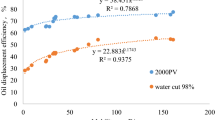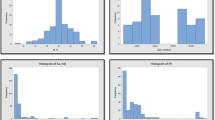Abstract
Sandstone oil reservoirs with huge bottom water and high permeability are generally developed with high flow rate. After long-term water flooding (LTWF), the water flooding characteristics are quite different from that of original reservoir. In this paper, the effects of the PV number, viscosity, and displacement rate during LTWF are studied through experiments. The mechanism is analyzed based on analysis of changes in oil composition, rock mineral composition and wettability. The oil-water relative permeability curves, oil recovery and wettability were obtained with new experiments methods, which avoids the oil metering error by measuring oil and water separately. The research indicates that when the viscosity increases, the water phase permeability decreases, the residual oil saturation increases, and the water content rate increases earlier. A higher water flooding rate results in a higher ultimate recovery. A higher asphaltene content results in a higher viscosity and more oil-wet reservoir conditions. After LTWF, the wettability tends to water-wet, which is more favorable for heavy oil recovery. Moreover, LTWF reduces the clay content, which creates a more water-wet surface and a larger reservoir pore throat environment. This research provides insightful characteristics of offshore sandstone oil reservoirs, which can be used to enhance oil recovery.
摘要
强底水砂岩储层通常采用大排量水驱开发, 长期水驱后储层水驱特征发生巨大变化。本文采用新的实验方法获得了油水相渗、采收率以及润湿性曲线, 并基于试验结果研究了水驱体积倍数、原油黏度及驱替速度对长期水驱的影响。通过对原油组成、岩石矿物组成以及润湿性变化进行分析, 明确了长期水驱过程中流固相互作用机理。研究表明, 随着原油黏度的增加, 水相渗透率降低, 剩余油饱和度增加, 含水率上升提前。较高的水驱速度会导致较高的最终采收率。沥青质含量越高, 黏度越高, 储层越偏油湿。长期水驱后后润湿性趋于水湿, 更有利于稠油开采。此外, 长期水驱降低了粘土含量, 形成了更偏水湿的岩石表面以及更大的储层孔喉环境。本研究为海上砂岩油藏开发及提采提供了一定的理论依据。
Similar content being viewed by others
References
DAVIS R A, MCELHINEY J E. Desulfated seawater and its impact on t-SRB activity: An alternative souring control methodology [C]//NACE Annual Conference, Corrosion, 2002. Denver, Colorado: Onepetro, 2002: 02028.
BADER M S H. Sulfate removal technologies for oil fields seawater injection operations [J]. Journal of Petroleum Science and Engineering, 2007, 55(1, 2): 93–110. DOI: https://doi.org/10.1016/j.petrol.2006.04.010.
ZHOU Wei, ZHANG Jian, FENG Gui-zhi, JIANG Wei, SUN Fu-jie, ZHOU Shou-wei, LIU Yi-gang. Key technologies of polymer flooding in offshore oilfield of Bohai bay [C]//SPE Asia Pacific Oil and Gas Conference and Exhibition. Perth, Australia: Society of Petroleum Engineers, 2008. DOI: https://doi.org/10.2118/115240-ms.
BADER M S H. Innovative technologies to solve oil-fields water injection sulfate problems [J]. Desalination, 2006, 201(1–3): 121–129. DOI:https://doi.org/10.1016/j.desal.2005.09.042.
KANG Xiao-dong, ZHANG Jian, SUN Fu-jie, ZHANG Feng-jiu, FENG Guo-zhi. A review of polymer EOR on offshore heavy oil field in Bohai Bay, China [C]//SPE Enhanced Oil Recovery Conference. Kuala Lumpur, Malaysia: Society of Petroleum Engineers, 2011. DOI: https://doi.org/10.2118/144932-ms.
SU Bao-wei, DOU Mao-wei, GAO Xue-li, SHANG Yan-wu, GAO Cong-jie. Study on seawater nanofiltration softening technology for offshore oilfield water and polymer flooding [J]. Desalination, 2012, 297: 30–37. DOI: https://doi.org/10.1016/j.desal.2012.04.014.
CARLL J F. The geology of the oil regions of Warren, Venango, Clarion, and Butler counties: Including surveys of the Garland and Panama Conglomerates in Warren and Crawford, and in Chautauqua Co., NY [M]//Descriptions of Oil Well Rigs and Tools, and a Discussion of the Preglacial and Postglacial Drainage of Lake Erie County Board of Commissioners, 1880.
LEVERETT M C. Capillary behavior in porous solids [J]. Transactions of the AIME, 1941, 142(1): 152–169. DOI: https://doi.org/10.2118/941152-g.
WELGE H J. A simplified method for computing oil recovery by gas or water drive [J]. Journal of Petroleum Technology, 1952, 4(4): 91–98. DOI: https://doi.org/10.2118/124-g.
ANDERSON W G. Wettability literature survey-part 1: Rock/oil/brine interactions and the effects of core handling on wettability [J]. Journal of Petroleum Technology, 1986, 38(10): 1,125–1,144. DOI: https://doi.org/10.2118/13932-pa.
BERNARD G G. Effect of floodwater salinity on recovery of oil from cores containing clays [C]//SPE California Regional Meeting. Los Angeles, California: Society of Petroleum Engineers, 1967: SPE-1725-MS. DOI: https://doi.org/10.2118/1725-ms.
LAGER A, COLLINS I R. LoSalTM enhanced oil recovery: Evidence of enhanced oil recovery at the reservoir scale [C]//SPE Symposium on Improved Oil Recovery. Tulsa, Oklahoma, Society of Petroleum Engineers, 2008: SPE-1139676-MS.
VLEDDER P, FONSECA J C, WELLS T, GONZALES I, LIGHTHELM D, PARK K, RIJSWIJK G. Low salinity water flooding: proof of wettability alteration on a field wide scale [C]//SPE Improved Oil Recovery Symposium. Tulsa, Oklahoma: Society of Petroleum Engineers, 2010. DOI: https://doi.org/10.2118/129564-ms.
CHANDRASEKHAR S, MOHANTY K K. Effect of brine composition on oil-rock interaction by atomic force microscopy [J]. Journal of Petroleum Science and Engineering, 2018, 164: 289–301. DOI: https://doi.org/10.1016/j.petrol.2018.02.001.
XIAO Rong, GUPTA R, GLOTZBACH R C, SINHA S, TELETZKE G F. Evaluation of low-salinity waterflooding in Middle East carbonate reservoirs using a novel, field-representative coreflood method [J]. Journal of Petroleum Science and Engineering, 2018, 163: 683–690. DOI: https://doi.org/10.1016/j.petrol.2017.10.070.
WEBB K J, BLACK C J J, AL-AJEEL H. Low salinity oil recovery-log-inject-log [C]//Middle East Oil Show. Tulsa, Oklahoma: Society of Petroleum Engineers, 2003.
WEBB K J, BLACK C J J, EDMONDS I J. Low salinity oil recoveng-the role of reservior condition corefloods [C]//IOR 2005-13th European Symposium on Improved Oil Recovery Budapest, Hungary: European Association of Geoscientists & Engineers, 2005: cp-12-00045.
RIVET S M. Coreflooding oil displacements with low salinity brine [D]. Austin, Texas: Petroleum and Geosystems Engineering of the University of Texas, 2009.
FJELDE I, ASEN S M, OMEKEH A V. Low salinity water flooding experiments and interpretation by simulations [C]//SPE Improved Oil Recovery Symposium. Tulsa, Oklahoma, USA Society of Petroleum Engineers, 2012: SPE-154142-MS.
NASRALLA R A, MAHANI H, VAN DER LINDE H A, MARCELIS F H, MASALMEH S K, SERGIENKO E, BRUSSEE N J, PIETERSE S G, BASU S. Low salinity waterflooding for a carbonate reservoir: Experimental evaluation and numerical interpretation [J]. Journal of Petroleum Science and Engineering, 2018, 164: 640–654. DOI: https://doi.org/10.1016/j.petrol.2018.01.028.
NUTTING P G. Some physical and chemical properties of reservoir rocks bearing on the accumulation and discharge of oil: Part V. Porosity, permeability, compaction [J]. AAPG Special Volumes, 1934: 825–832.
LEACH R O, WAGNER O R, WOOD H W, HARPKE C F. A laboratory and field study of wettability adjustment in water flooding [J]. Journal of Petroleum Technology, 1962, 14(2): 206–212. DOI: https://doi.org/10.2118/119-pa.
DENEKAS M O, MATTAX C C, DAVIS G T. Effects of crude oil components on rock wettability [J]. Society of Petroleum Engineers, 1959, 216: 330–333. DOI: https://doi.org/10.2118/1276-g.
BUCKLEY J S, LIU Yue, XIE Xi-na, MORROW N R. Asphaltenes and crude oil wetting-The effect of oil composition [J]. SPE Journal, 1997, 2(2): 107–119. DOI: https://doi.org/10.2118/35366-pa.
TAVAKKOLI M, PANUGANTI S R, VARGAS F M, TAGHIKHANI V, PISHVAIE M R, CHAPMAN W G. Asphaltene deposition in different depositing environments: Part 1. Model oil [J]. Energy & Fuels, 2014, 28(3): 1617–1628. DOI: https://doi.org/10.1021/ef401857t.
CAI Yi, YANG Lei, ZHAO Yue-hua, WANG Zhi-zhang. Variation law of the micro-geological features of the reservoir before and after a long term water flooding in He3 reservoir of Shuanghe oilfield [J]. Petroleum Geology & Oilfield Development in Daqing, 2004, 23(1): 24–26. (in Chinese)
GAO Pei-ke, TIAN Hui-mei, LI Guo-qiang, SUN Hong-wen, MA Ting. Microbial diversity and abundance in the Xinjiang Luliang long-term water-flooding petroleum reservoir [J]. Microbiology Open, 2015, 4(2): 332–342. DOI: https://doi.org/10.1002/mbo3.241.
CAO Ren-yi, SUN Chang-wei, MA Y Z. Modeling wettability variation during long-term water flooding [J]. Journal of Chemistry, 2015, 2015. DOI: https://doi.org/10.1155/2015/592951.
JI Shu-hong, TIAN Chang-bing, SHI Cheng-fang, YE Ji-gen, ZHANG Zu-bo, FU Xiu-juan. New understanding on water-oil displacement efficiency in a high water-cut stage [J]. Petroleum Exploration and Development, 2012, 39(3): 362–370. DOI: https://doi.org/10.1016/s1876-3804(12)60052-4.
DAI Zong, JIANG Jun, LI Hai-long, CAO Ren-yi, XIN Jing, LUO Dong-hong. Wetability experiment of core and mico-mechanism during high-multiple water flooding in heavy oil reservoir [J]. Science Technology an Engineering, 2019, 33(19): 157–163. (in Chinese)
YANG Bai-juan, ZHENG Li, ZHANG Kui-ying, CUI Zhi-song, WANG Xiao-ru, LI Xian-chun. Study on SARA composition of crude oil by TCL/FID [J]. Chemical Engineering of Oil & GAS, 2011, 40(2): 201–203, 222, 101. (in Chinese)
ARGILLIER J F, COUSTET C, HENAUT I. Heavy oil rheology as a function of asphaltene and resin content and temperature [C]//SPE International Thermal Operations and Heavy Oil Symposium and International Horizontal Well Technology Conference. Calgary, Alberta, Canada: Society of Petroleum Engineers, 2002.
CROCKER M E, MARCHIN L M. Wettability and adsorption characteristics of crude-oil asphaltene and polar fractions [J]. Journal of Petroleum Technology, 1988, 40(4): 470–474. DOI: https://doi.org/10.2118/14885-pa.
STRAND S, PUNTERVOLD T, AUSTAD T. Water based EOR from clastic oil reservoirs by wettability alteration: A review of chemical aspects [J]. Journal of Petroleum Science and Engineering, 2016, 146: 1079–1091. DOI: https://doi.org/10.1016/j.petrol.2016.08.012.
WU Jia-wen. Study on wettability change with optical contact angle measuring device [J]. Fualt-Block Oil field, 2011, 18(2): 220–222. (in Chinese)
HUANG Shi-jun, SUN Chang-wei, CHANG Yang, ZHAO Ming-yue. Contact angle alteration for cores under multiplex pore volume water flooding [J]. Science Technology and Engineering, 2016, 16(4): 178–181. (in Chinese)
LI Su-mei, ZHANG Ai-yun, WANG Tie-guan. The absorption of oil polar component and reservoir wettability [J]. Geological Science and Technology Information, 1998(4): 66–71. (in Chinese)
ZHANG Li-hu, LU Xian-cai, LIU Xian-dong, YANG Kan, ZHOU Hui-qun. Surface wettability of basal surfaces of clay minerals: Insights from molecular dynamics simulation [J]. Energy & Fuels, 2016, 30(1): 149–160. DOI: https://doi.org/10.1021/acs.energyfuels.5b02142.
MAMONOV A, PUNTERVOLD T, STRAND S. EOR by smart water flooding in sandstone reservoirs-effect of sandstone mineralogy on initial wetting and oil recovery [C]//SPE Russian Petroleum Technology Conference. Society of Petroleum Engineers, 2017.
ZHAO Bo, ZHANG Guang-qing, BAI Xiao-hui, ZHUANG Jian-man, LIN Ying, LV Yan-jun, NIE Yuan-xun. The effects of long-term waterflooding on the physical and mechanical properties of tight sandstones [C]//52nd US Rock Mechanics/Geomechanics Symposium. American Rock Mechanics Association, 2018.
TANG Guo-qing, MORROW N R. Influence of brine composition and fines migration on crude oil/brine/rock interactions and oil recovery [J]. Journal of Petroleum Science and Engineering, 1999, 24(2–4): 99–111. DOI: https://doi.org/10.1016/s0920-4105(99)00034-0.
Author information
Authors and Affiliations
Corresponding author
Additional information
Foundation item
Project(51674273) supported by the National Natural Science Foundation of China; Project(CNOOC-KJ135ZDXM22LTD02SZ2016) supported by the Major Science and Technology Projects of CNOOC, China
Contributors
The overarching research goals were developed by CAO Ren-yi, DAI Zong and WANG Yan-hui. JIANG Jun and WANG Zhi-kai provided the data of long-term waterflooding, and analyzed the measured data. The initial draft of the manuscript was written by WANG Zhi-kai, LI hai-long and JIA Zhi-hao. All authors replied to reviewers’ comments and revised the final version.
Conflict of interest
CAO Ren-yi, DAI Zong, WANG Zhi-kai, WANG Ya-hui, JIANG Jun, LI Hai-long and JIA Zhi-hao declare that they have no conflict of interest.
Rights and permissions
About this article
Cite this article
Cao, Ry., Dai, Z., Wang, Zk. et al. Displacement behavior and mechanism of long-term water flooding in sandstone oil reservoirs. J. Cent. South Univ. 28, 834–847 (2021). https://doi.org/10.1007/s11771-021-4648-3
Received:
Accepted:
Published:
Issue Date:
DOI: https://doi.org/10.1007/s11771-021-4648-3




